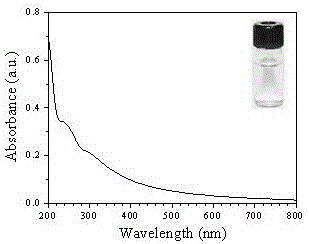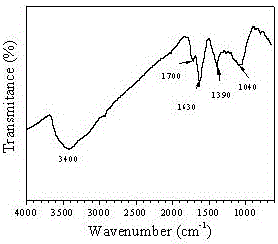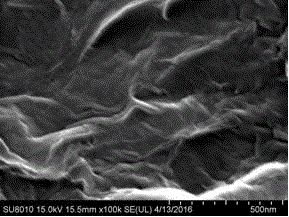Chemical preparation method of graphene quantum dot fluorescence probe used for detecting trace of TNT (trinitrotoluene)
A technology of graphene quantum dots and fluorescent probes, applied in the field of material science, can solve the problems of unfriendly environment, complicated synthesis steps of detection materials, and insufficient specificity and sensitivity.
- Summary
- Abstract
- Description
- Claims
- Application Information
AI Technical Summary
Problems solved by technology
Method used
Image
Examples
specific Embodiment approach
[0070] Specific embodiments: a chemical preparation method of a graphene quantum dot fluorescent probe for trace TNT detection, oxidizing graphite with an oxidizing agent to obtain graphene oxide, reducing graphene oxide with a strong reducing agent, and finally performing a process with reduced graphene A series of reactions make blue and green graphene quantum dot fluorescent probes, which are characterized in that: the surface of the graphene quantum dot fluorescent probes is electron-rich, and the three electron-deficient nitro groups of the target analyte TNT molecule are electron-absorbing When the groups are close to each other in space, fluorescence resonance energy transfer occurs, and the detection of trace TNT is realized through the change of the fluorescence intensity of the graphene quantum dot fluorescent probe. The preparation process of the graphene quantum dot fluorescent probe includes Follow these three steps:
[0071] 1.1 The first step is the preparation ...
Embodiment
[0075] Embodiment: Using graphite as a raw material, graphene quantum dot fluorescent probes can be obtained through three-step reactions.
[0076] The first step is the preparation of graphene oxide: First, measure 20mL of HClO 4 Put it into a 100mL three-neck round bottom flask, place the above flask in a water bath, adjust the water temperature with ice cubes to keep it at about 0~5°C, then weigh 0.9845g of graphite with an electronic balance with an accuracy of 1 / 10,000, add In the above-mentioned flask, after stirring and reacting for 30min with 500rpm rotating speed, weigh 2.9756g of K 2 Cr 2 o 7 , continuously and slowly add to the above-mentioned flask within 1 hour, continue to stir and react for 1 hour, raise the temperature of the water bath to 35°C and continue to stir for 30 minutes, then slowly add 10 mL of deionized water to the above-mentioned flask, and seal the liquid surface of the water bath with silicone oil , connect the three-neck round bottom flask t...
PUM
 Login to View More
Login to View More Abstract
Description
Claims
Application Information
 Login to View More
Login to View More - Generate Ideas
- Intellectual Property
- Life Sciences
- Materials
- Tech Scout
- Unparalleled Data Quality
- Higher Quality Content
- 60% Fewer Hallucinations
Browse by: Latest US Patents, China's latest patents, Technical Efficacy Thesaurus, Application Domain, Technology Topic, Popular Technical Reports.
© 2025 PatSnap. All rights reserved.Legal|Privacy policy|Modern Slavery Act Transparency Statement|Sitemap|About US| Contact US: help@patsnap.com



